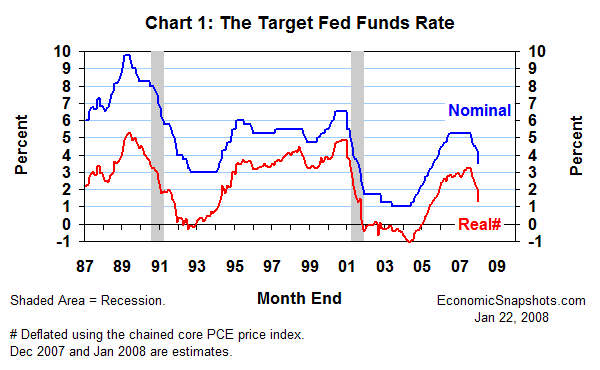
| Back to Index |
January 22, 2008 – Today, the FOMC reduced its target Fed funds rate by 75 basis points to 3.5% (Chart 1). This was the largest daily decline in the Fed funds target in the available data (since September 28, 1982).

The FOMC has now reduced its Fed funds target by a total of 175 basis points, since mid-September last year.
Size wasn’t the only distinguishing feature of today’s Fed action. The FOMC usually waits until one of its regular policy meetings to make changes in U.S. monetary policy. This was the first inter-meeting easing move since September 17, 2001 – after the September 11 terrorist attacks.
In its policy statement, the FOMC blamed today’s easing action on “a weakening of the economic outlook and increasing downside risks to growth. While strains in short-term funding markets have eased somewhat, broader financial market conditions have continued to deteriorate and credit has tightened further for some businesses and households. Moreover, incoming information indicates a deepening of the housing contraction as well as some softening in labor markets.”
These remarks don’t explain the unusual timing. Why today? The FOMC’s next regular policy meeting is only one week away (on January 29-30).
The FOMC was clearly divided on this point. St. Louis Fed President Poole voted against today’s easing move. He would have preferred to wait until the meeting next week to take any policy action.
Very likely, the FOMC majority voted to ease sooner to soothe the financial markets. The U.S. markets were closed on Monday for the Martin Luther King holiday. But, sharp declines in the foreign stock markets on both Monday and early Tuesday suggested that there might be trouble coming when the U.S. markets reopened today.
It’s not the Fed’s job to keep stock prices rising. However, as Fed Chairman Bernanke indicated earlier this month, the FOMC has been worrying all along that a development of this nature might exacerbate the U.S. credit crunch.
The press release also noted that the FOMC hasn’t forgotten its commitment to price stability. Right now, however, the FOMC majority is clearly more worried about a U.S. recession than it is about inflation.
Even after today’s aggressive easing action, “Appreciable downside risks to growth remain. The Committee will continue to assess the effects of financial and other developments on economic prospects and will act in a timely manner as needed to address those risks.”
Bottom line: it’s too soon to rule out further Fed easing.
Suzanne Rizzo